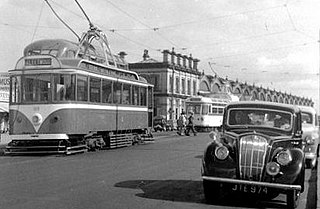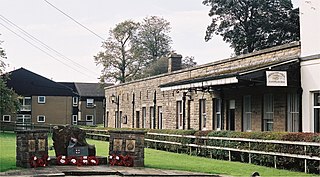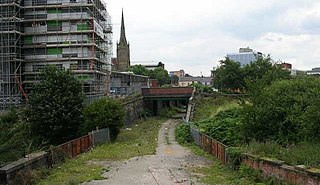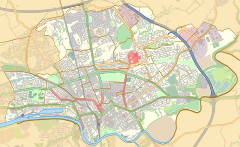
The London and North Western Railway was a British railway company between 1846 and 1922. In the late 19th century, the L&NWR was the largest joint stock company in the United Kingdom.

The Lancashire and Yorkshire Railway (L&YR) was a major British railway company before the 1923 Grouping. It was incorporated in 1847 from an amalgamation of several existing railways. It was the third-largest railway system based in northern England.

The Calder Valley line is a railway route in Northern England between the cities of Leeds and Manchester as well as the seaside resort of Blackpool. It is the slower of the two main rail routes between Leeds and Manchester, and the northernmost of the three main trans-Pennine routes.

The Manchester and Leeds Railway was a British railway company that built a line from Manchester to Normanton where it made a junction with the North Midland Railway, over which it relied on running powers to access Leeds. The line followed the valley of the River Calder for much of the way, making for easier gradients but by-passing many important manufacturing towns. Crossing the watershed between Lancashire and Yorkshire required a long tunnel. The line opened throughout in 1841.
The Preston and Wyre Railway was promoted to open up agricultural land in the Fylde in Lancashire, access a new port at what became Fleetwood and the Lancaster Canal at Preston: it opened in 1840. An associated company built the dock leading to the company changing its name to the Preston and Wyre Railway, Harbour and Dock Company. Passenger business was more buoyant than expected, and the company built branch lines to the nascent resort of Blackpool and Lytham that opened in 1846. At that time the line was leased by the Lancashire and Yorkshire Railway and later the London and North Western Railway took a share in the lease which was later converted to outright ownership. The Preston and Wyre Railway continued to be jointly owned as the Preston and Wyre Joint Railway.

Preston railway station in Preston, Lancashire, England, is a major station on the West Coast Main Line, roughly half-way between London Euston and Glasgow Central. It is served by Avanti West Coast, Northern Trains and TransPennine Express services, plus Caledonian Sleeper overnight services between London and Scotland. It is also served by the Calder Valley line to Leeds and York, and by branch lines to Blackpool, Ormskirk, and Colne.

Bamber Bridge railway station serves the area of Bamber Bridge, England 4 miles (6 km) to the south of Preston city centre on the A6 and M6 roads. It is situated on the East Lancashire Line and is managed by Northern.
The Fleetwood branch line consists of the railway line from Preston to Fleetwood. It passed through many smaller stations along the way. When work at Fleetwood docks was under threat in the mid-1960s, the main Fleetwood station was closed; the remainder of the branch south to Poulton followed in 1970. Proposals exist to re-open the branch to passenger services in the near future.

Thornton–Cleveleys was a railway station in England which served the Lancashire village of Thornton and town of Cleveleys. Located on the now disused line between Poulton-le-Fylde and Fleetwood, the station also had a shunting yard for the making-up of freight trains for Preston and beyond. During its life it was also known at times as Thornton station and Thornton for Cleveleys station. In the 1860s and early 1870s the line was of great importance, being the direct route from London to Glasgow. Before the Shap route was opened, passengers would travel from Euston to Fleetwood and then onwards via steamer to Scotland.

There have been three locations for Fleetwood railway station in Fleetwood, Lancashire, England. The first, from 1840 to 1883, was in Dock Street, opposite Church Street. The second, from 1883 to 1966, was in Queen's Terrace. From 1966 to 1970, the station previously known as Wyre Dock railway station was renamed "Fleetwood".

Grimsargh railway station was on the single track Preston and Longridge Railway. It served the village of Grimsargh in Lancashire, England.

Longridge railway station was a passenger terminus of the Preston and Longridge Railway. It served the town of Longridge in Lancashire, England.
The Preston and Longridge Railway (P&LR) was a branch line in Lancashire, England. Originally designed to carry quarried stone in horse-drawn wagons, it became part of an ambitious plan to link the Lancashire coast to the heart of Yorkshire. The ambition was never achieved, but the line continued to carry passengers until 1930 and goods until 1967.

Ribbleton railway station was on the Preston and Longridge Railway in Ribbleton, a suburb of Preston, Lancashire, England.

Maudland Bridge railway station was once the Preston terminus of the Longridge Branch Line, in Lancashire, England. It was located on Maudland Road, between a bridge over the Lancaster Canal and Cold Bath Street. The Maudlands district of Preston gets its name from the medieval St. Mary Magdalen's leper hospital, which once stood near the present-day St Walburge's Church.

Barnoldswick railway station was the only railway station on the Midland Railway's 1-mile-64-chain (2.9 km) long Barnoldswick Branch in the West Riding of Yorkshire in England. It served the market town of Barnoldswick, which was in West Riding of Yorkshire at the time. The line left the Leeds and Bradford Extension Railway at Barnoldswick Junction 55 chains from Earby railway station. The line through the junction was on a 20-chain radius after which it converged to a single track and ran in a straight but undulating line to Barnoldswick. The passenger train that ran back and forth between Barnoldswick and Earby was known locally as the 'Barlick Spud' or 'Spudroaster'. The real reason for the name is lost in time, but the two versions that were commonly recited are that the original branch locomotive was so small it looked like a portable potato roaster used by a local vendor or that the journey time was the same as that taken to roast a potato in the locomotive's firebox.
Deepdale Street railway station was the original Preston terminus of the Preston and Longridge Railway in Lancashire, England, when it first opened in 1840. It was located in Deepdale Street, off Deepdale Road, on what was then the outskirts of Preston. The rail line was originally designed to carry quarried stone from Longridge to Preston, so the passenger facilities were quite rudimentary and there were many sidings near the station for unloading stone.
The Whittingham Hospital Railway (W.H.R.) was a private light railway operated by Lancashire County Council to serve Whittingham lunatic asylum. Opened in 1889, it carried goods and passengers between Grimsargh on the Preston and Longridge Railway and the hospital grounds. It closed to all traffic in 1957.

Maudlands railway station was the original Preston terminus of the Preston and Wyre Joint Railway to Fleetwood, in Lancashire, England. It was located on Leighton Street. The line and the station opened on 15 July 1840. The line crossed the Lancaster and Preston Junction Railway (L&PJR) on the level, immediately to the west of the station.

Preston is a city in Lancashire, around 50 kilometres (31 mi) north-west of Manchester.

















